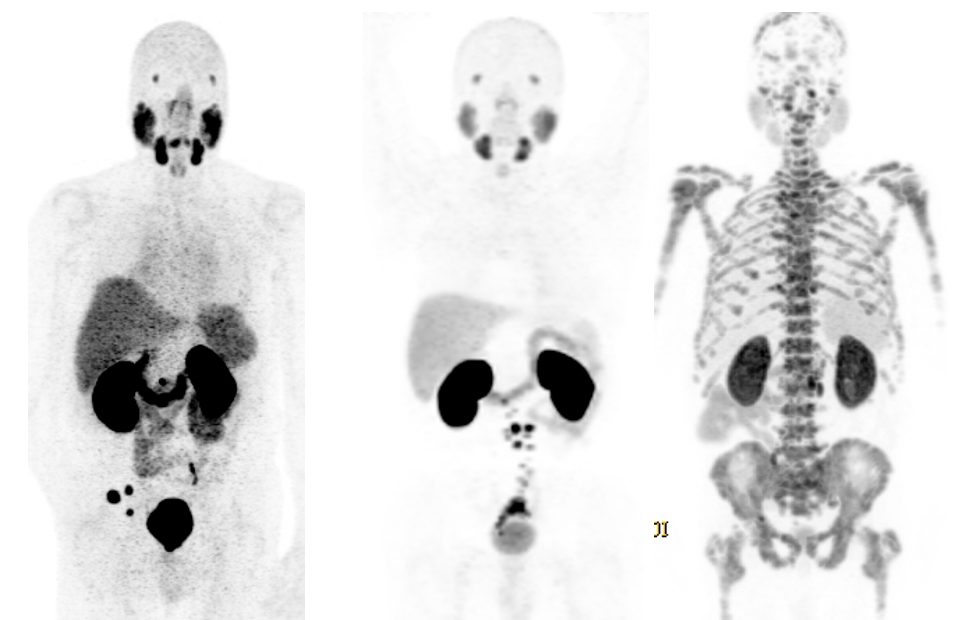PET-CT-SCAN

- PET-CT (FDG 18) Scan.........8,000 AED
- PET-CT PSMA Scan..............14,000 AED
- Chemotherapy....................Contact Us
- Radiationtherapy................Contact Us
- Immunotherapy..................Contact Us
- Insurance covered..............Contact Us
- Insurance covered..............Contact Us
A procedure in which a small amount of radioactive glucose (sugar) is injected into a vein, and a scanner is used to make detailed, computerized pictures of areas inside the body where the glucose is taken up
PSMA PET is a diagnostic tool that uses a type of medical imaging called positron emission tomography (PET) to detect prostate cancer anywhere in the body. PSMA stands for prostate-specific membrane antigen, a protein found on the surface of prostate cancer cells.
Chemotherapy kills cells that are in the process of splitting into 2 new cells. Body tissues are made of billions of individual cells. Once we are fully grown, most of the body’s cells don’t divide and multiply much. They only divide if they need to repair damage.
Radiation therapy is a cancer treatment that uses high-energy x-ray or other particles to destroy cancer cells. A doctor who specializes in giving radiation therapy to treat cancer is called a radiation oncologist.
Immunotherapy is a type of cancer treatment. It uses substances made by the body or in a laboratory to boost the immune system and help the body find and destroy cancer cells. Immunotherapy can treat many different types of cancer. It can be used alone or in combination with chemotherapy and/or other cancer treatments.
Exploring the Power of PET-CT Scans: FDG-18 and PSMA
Medical science has made astonishing strides in diagnostic imaging, and one remarkable innovation that has emerged is the Positron Emission Tomography-Computed Tomography (PET-CT) scan. Among the various PET-CT radiopharmaceuticals, two that stand out are FDG-18 and PSMA. In this article, we’ll delve into the significance and applications of PET-CT scans using FDG-18 and PSMA tracers, shedding light on how these cutting-edge technologies have revolutionized cancer diagnosis and management.
Understanding PET-CT Scans
PET-CT scans are a medical imaging technique that combines two powerful modalities: Positron Emission Tomography (PET) and Computed Tomography (CT). PET involves the injection of a radioactive substance, known as a radiopharmaceutical, into the body. This substance emits positrons, which collide with electrons in the body, producing gamma rays. A PET scanner detects these gamma rays, creating images that represent metabolic activity in different tissues.
On the other hand, CT provides detailed anatomical images of the same area. By combining metabolic data from PET with anatomical data from CT, PET-CT scans offer comprehensive information about both the structure and function of tissues and organs. This makes them particularly valuable for cancer diagnosis and staging.
FDG-18: The Standard in PET-CT Scans
FDG-18 (Fluorodeoxyglucose-18) is the most commonly used radiopharmaceutical in PET-CT scans. It is a glucose analog labeled with a radioactive isotope of fluorine-18. Cancer cells are known to be metabolically active and tend to take up more glucose than normal cells. FDG-18 takes advantage of this metabolic difference.
When a patient receives an FDG-18 PET-CT scan, the radiopharmaceutical is injected into their bloodstream. It is quickly absorbed by the body, including cancer cells. As the FDG-18 accumulates in these cells, it emits positrons. The PET scanner then detects these positrons, creating images that highlight areas with increased metabolic activity, typically indicative of cancer.
Applications of FDG-18 PET-CT
FDG-18 PET-CT scans have a wide range of applications in oncology. They are used for:
Cancer Diagnosis: FDG-18 PET-CT scans can detect various types of cancer, including lung, breast, and colorectal cancer. They are often used to determine the extent and location of tumors in the body.
Staging: PET-CT scans are essential for determining the stage of cancer. They help doctors understand if the cancer has spread to nearby lymph nodes or distant organs.
Treatment Monitoring: After cancer treatment, such as chemotherapy or radiation therapy, FDG-18 PET-CT scans are used to assess the treatment’s effectiveness. They can show whether the metabolic activity of the tumor has decreased, which is a positive sign.
Cancer Recurrence: FDG-18 PET-CT scans are also employed to detect cancer recurrence. They can identify small areas of increased metabolic activity that may indicate the return of cancer.
Radiotherapy Planning: In radiation therapy, precise targeting of the tumor is crucial. PET-CT scans help in delineating the tumor’s boundaries, allowing for more accurate radiation therapy planning.
PSMA PET-CT: A Game-Changer for Prostate Cancer
Prostate-specific membrane antigen (PSMA) PET-CT is a groundbreaking advancement in the field of oncology, particularly for prostate cancer. Unlike FDG-18, which relies on glucose uptake, PSMA PET-CT targets a protein that is highly expressed on the surface of prostate cancer cells.
PSMA PET-CT scans use a radiopharmaceutical called PSMA ligand labeled with a radioactive isotope, such as Gallium-68 or Fluorine-18. When injected into the patient’s bloodstream, the PSMA ligand binds specifically to PSMA receptors on prostate cancer cells.
Applications of PSMA PET-CT
PSMA PET-CT has revolutionized the diagnosis and management of prostate cancer:
Prostate Cancer Detection: PSMA PET-CT is incredibly sensitive in detecting prostate cancer, even at low PSA levels. This is particularly valuable for identifying recurrent or metastatic disease.
Staging: It provides detailed information about the extent and location of prostate cancer, aiding in accurate staging.
Treatment Planning: PSMA PET-CT helps in planning treatments, such as surgery or radiation therapy, by precisely identifying the location and extent of cancer.
Monitoring Therapy: It is instrumental in monitoring the response to prostate cancer treatments. Doctors can assess whether therapies are effectively targeting cancer cells.
Decision-Making: PSMA PET-CT scans provide critical information for treatment decisions, such as whether to pursue localized therapy or systemic treatment for metastatic disease.
Conclusion
PET-CT scans with FDG-18 and PSMA have revolutionized cancer diagnosis and management. FDG-18 PET-CT is a versatile tool for detecting, staging, monitoring, and treating various types of cancer. On the other hand, PSMA PET-CT has emerged as a game-changer in prostate cancer, offering unprecedented sensitivity and accuracy in diagnosis, staging, and treatment planning. These technologies continue to advance, promising even greater precision and effectiveness in the fight against cancer.